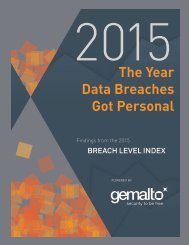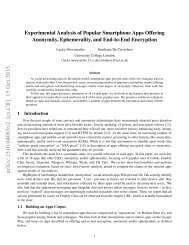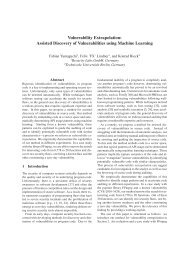Deobfuscating Embedded Malware using Probable-Plaintext Attacks
Deobfuscating Embedded Malware using Probable-Plaintext Attacks
Deobfuscating Embedded Malware using Probable-Plaintext Attacks
Create successful ePaper yourself
Turn your PDF publications into a flip-book with our unique Google optimized e-Paper software.
12 <strong>Deobfuscating</strong> <strong>Embedded</strong> <strong>Malware</strong> <strong>using</strong> <strong>Probable</strong>-<strong>Plaintext</strong> <strong>Attacks</strong><br />
does not rely on parsing the host file, we simply inject the obfuscated PE files<br />
at random positions. We end up with a total of 152,960 unique Word documents<br />
each containing an obfuscated PE file.<br />
100<br />
100<br />
Deobfuscation rate in percent<br />
80<br />
60<br />
40<br />
20<br />
0<br />
Kandi (r = 0.0)<br />
0 5 10 15 20 25 30<br />
Key length<br />
(a) Obfuscated PE files<br />
Deobfuscation rate in percent<br />
90<br />
80<br />
70<br />
60<br />
50<br />
40<br />
r = 0.0<br />
r = 0.5<br />
r = 1.0<br />
0 2 4 6 8 10 12<br />
Key length<br />
(b) Influence of the overlap ratio<br />
Fig. 5. Deobfuscation performance of Kandi on obfuscated PE files. Figure (b) shows<br />
the performance for different overlap ratios.<br />
Deobfuscation of Obfuscated PE Files. To demonstrate the capability of<br />
our method to break Vigenère-based obfuscations, we first apply Kandi to the<br />
152,960 obfuscated PE files. The probable plaintexts for this experiment are<br />
retrieved as described in Section 3.1 without further refinements. Figure 5(a)<br />
shows results for this experiment, where the key length is plotted against the<br />
rate of deobfuscated PE files. For key lengths up to 13 bytes, the obfuscation can<br />
be reliably broken with a success rate of 93% and more. This nicely illustrates<br />
the potential of Kandi to automatically deobfuscate malware. We also observe<br />
that the performance for keys longer than 13 bytes drops. While our approach<br />
is not capped to a specific key length, the limiting factor at this point is the<br />
collection of plaintexts and in particular the length of those.<br />
To study the impact of the plaintext length, we additionally apply Kandi<br />
with different values for the overlap ratio r as introduced in Section 3.3. The<br />
corresponding deobfuscation rates are visualized in Figure 5(b). Although a high<br />
value of r potentially increases the performance, it also reduces the number<br />
of plaintexts that can be used. If there are too few usable plaintexts, it gets<br />
difficult to estimate the correct key. As a result, Kandi attains a deobfuscation<br />
performance of almost 100% for r = 1.0 if the keys are short, but is not able to<br />
reliably break obfuscations with longer keys.<br />
Runtime Performance. We additionally examine the runtime performance of<br />
Kandi. For this purpose, we randomly draw 1,000 samples from the obfuscated<br />
PE files for each key length and repeat the previous experiment single-threaded<br />
on an Intel Core i7-2600K CPU at 3.40GHz running Ubuntu 12.04. As baseline<br />
for this experiment, we implement a generic brute-force attack that is applied to









